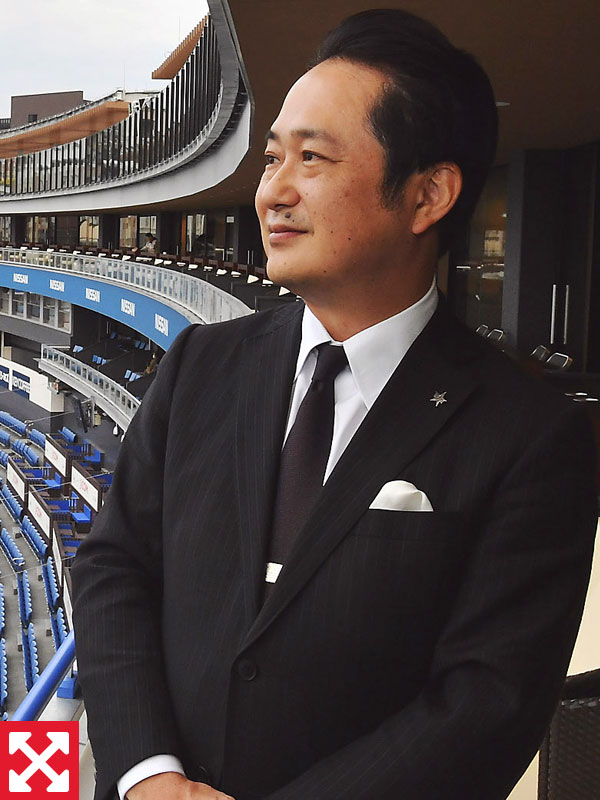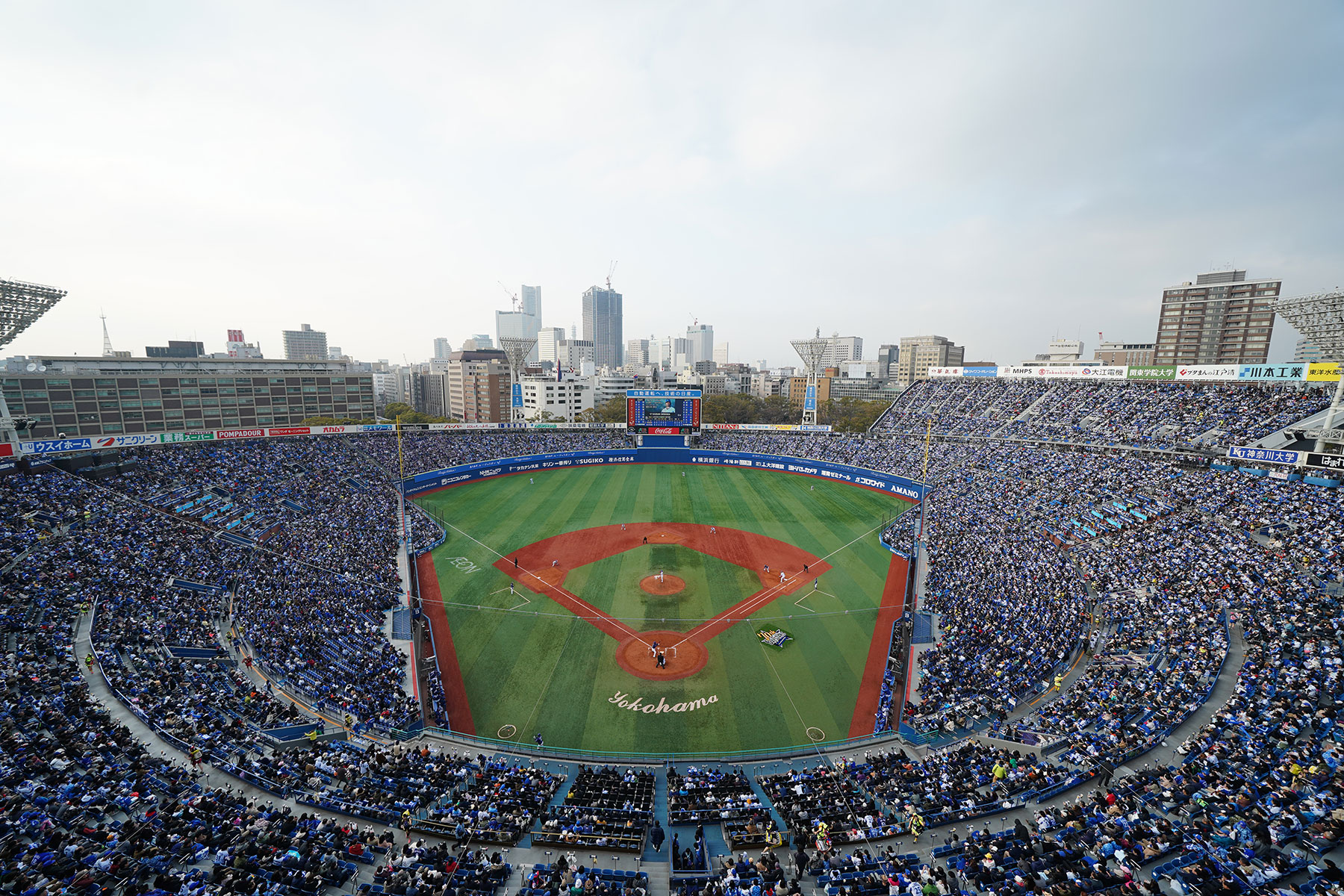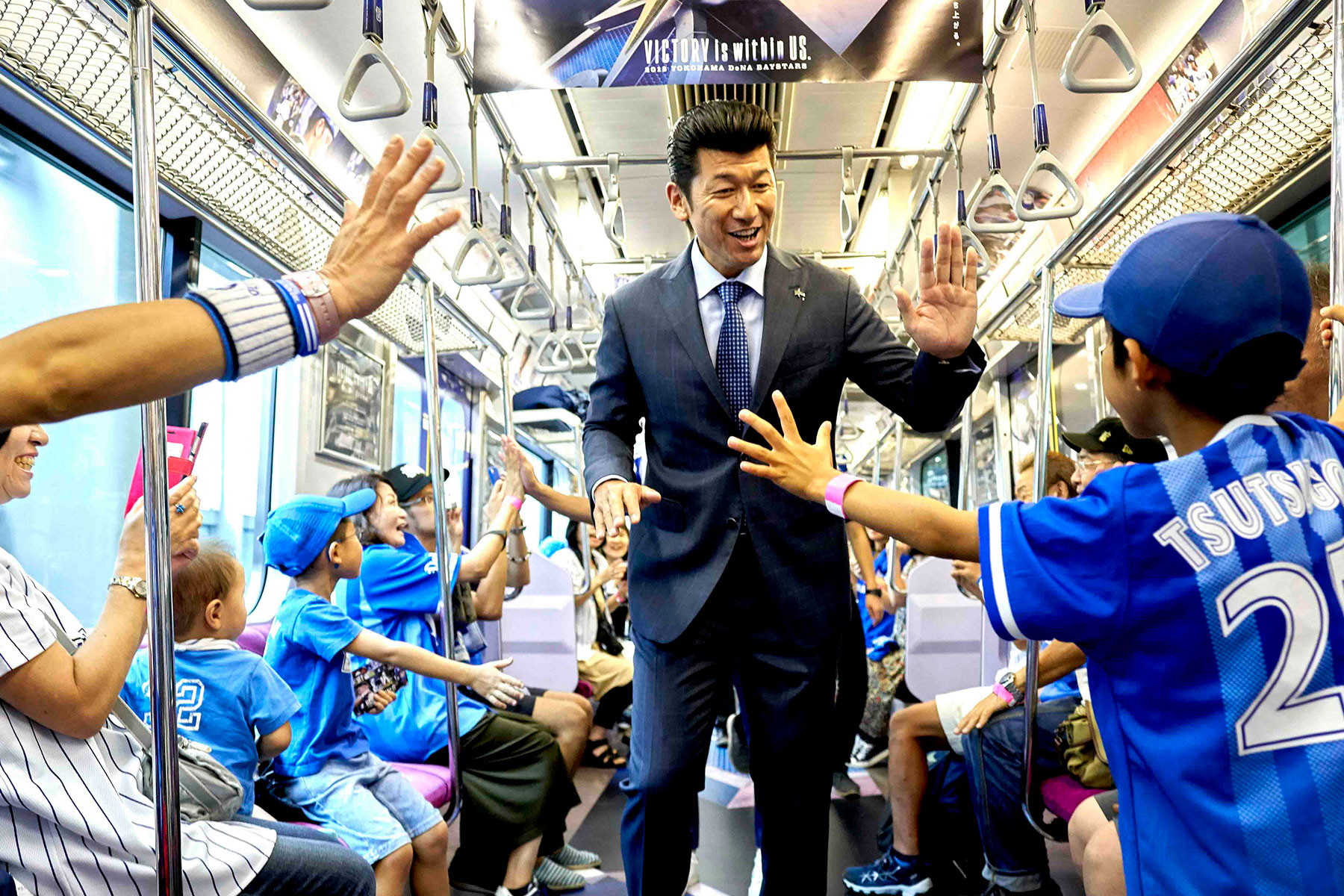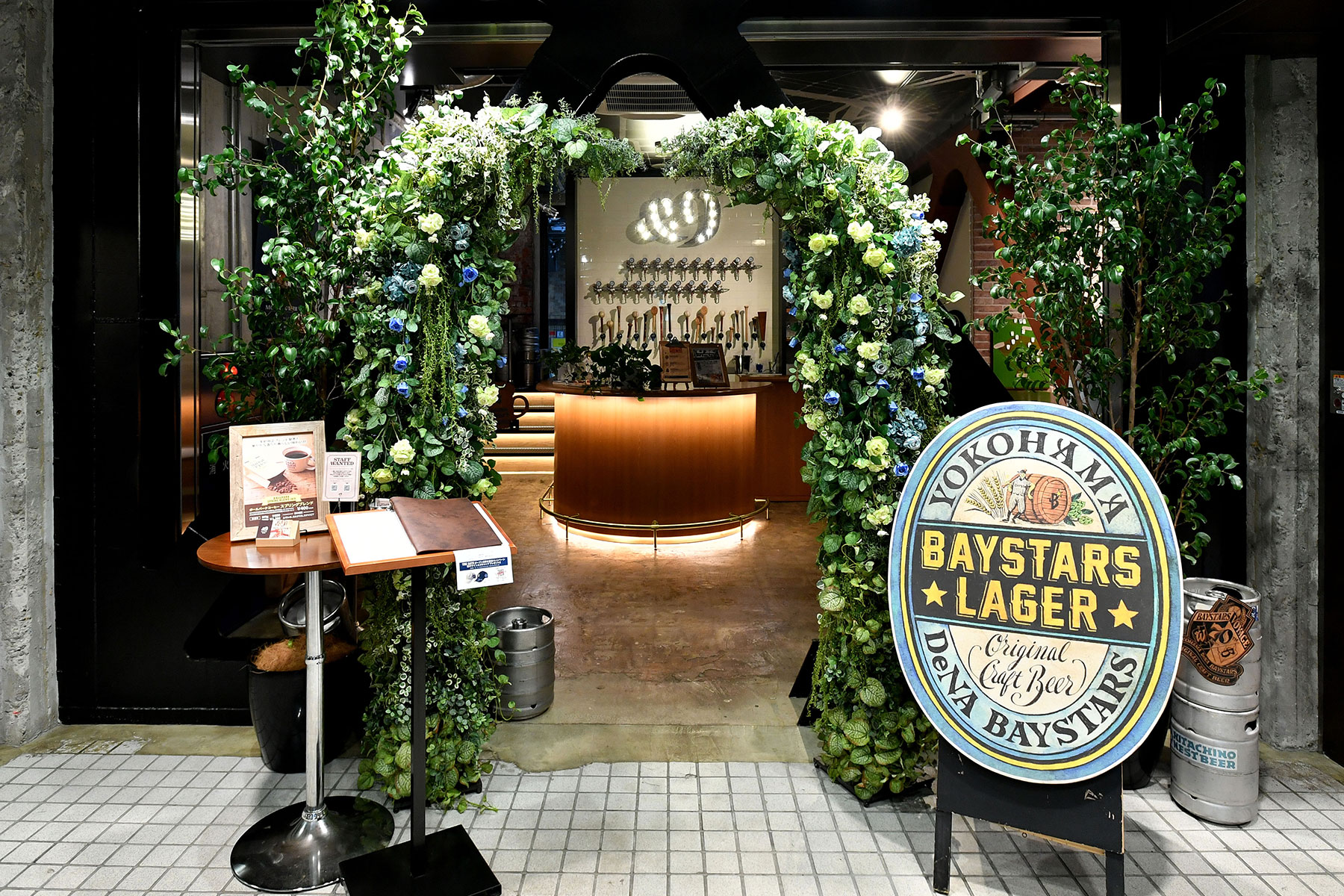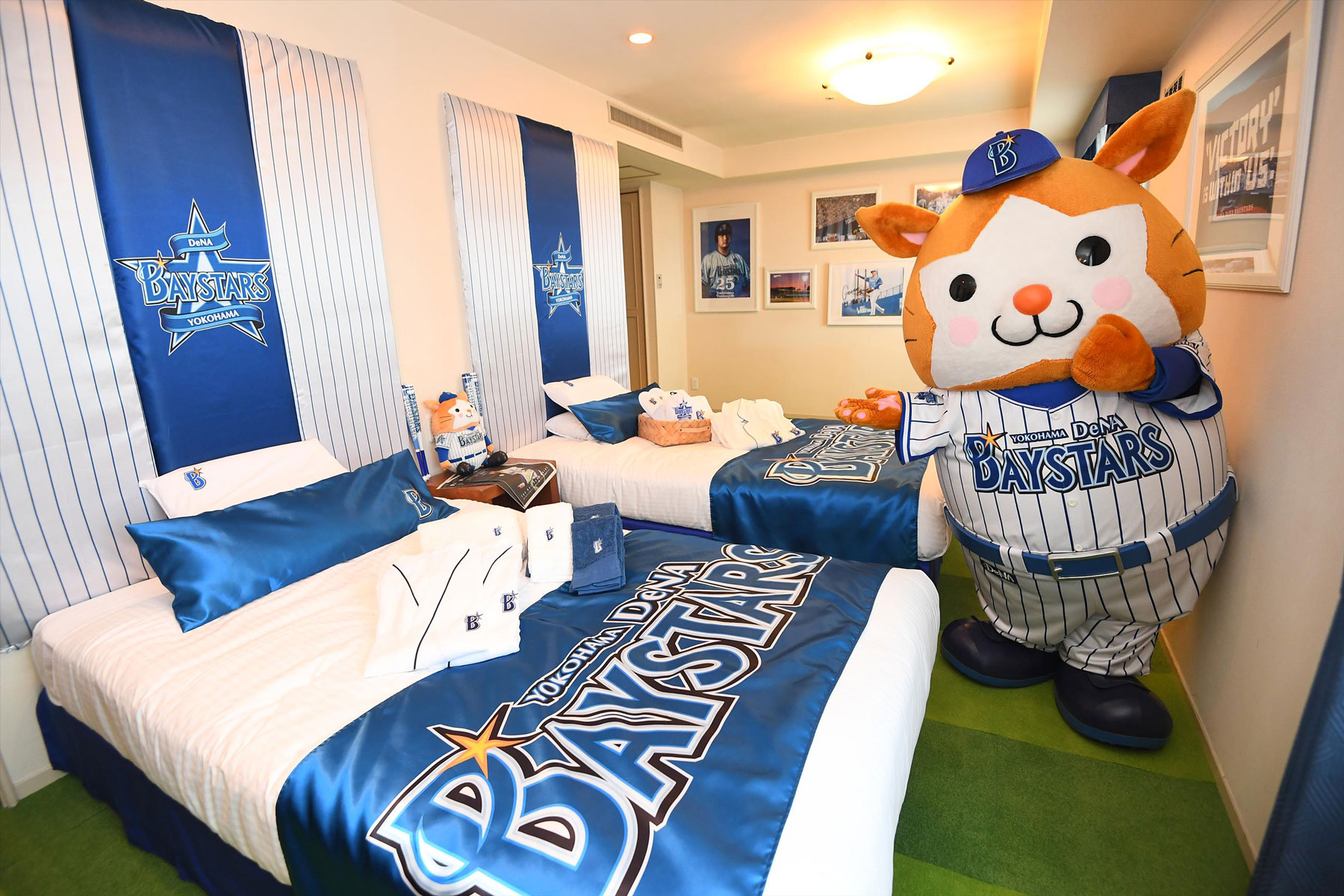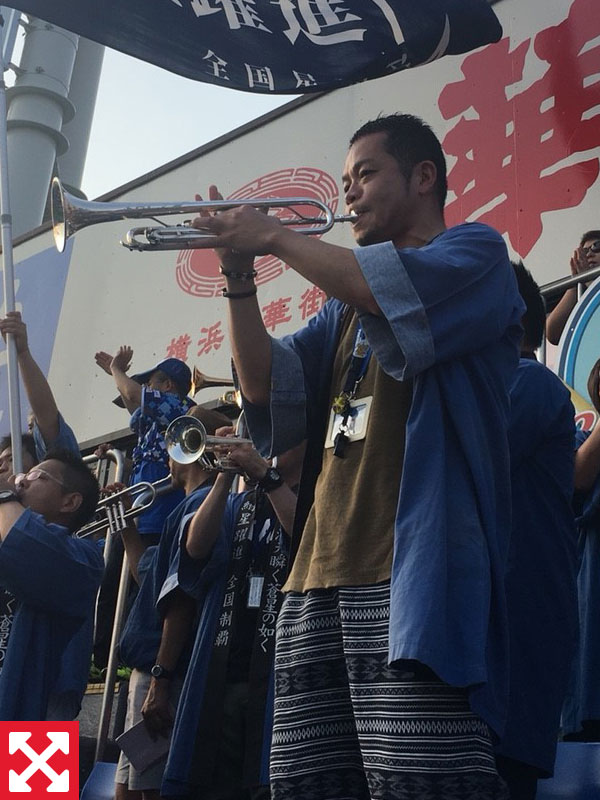SPORTS
BayStars get an upgrade
In Yokohama, it’s a whole new ballgame
The Yokohama DeNa BayStars at night. YDB
Pro baseball team uses stadium to build sports community in city
KAZ NAGATSUKA
Staff writer
Looking down at the sea of dark blue seats that frame one of Nippon Professional Baseball’s smallest playing fields, one thing becomes clear: For the Yokohama DeNA BayStars, the ballpark, and the myriad experiences it offers those who take in a game, is their top commodity.
Yokohama Stadium, with its improved aesthetics and revamped amenities spearheaded by its main tenant, has become the city’s place to be from spring to fall and sits at the heart of what the city and team hope will become a veritable sports mecca.
At the forefront of this ambitious initiative is Shingo Okamura, the president of the team and Yokohama Stadium Co., and, at 49, one of the brightest sports executives in the country.
Okamura has played a key part in transforming this 41-year-old bowl-shaped stadium, affectionately known as hamasuta by the club’s fans, into more than just a place to watch baseball.
Born in Tokyo, Okamura would watch the Yomiuri Giants and baseball-themed anime growing up. Decades later, however, he has found his life enveloped by the BayStars, a club long overshadowed by the 22-time champion Kyojin, who play their home games just an hour train ride away.
The day before his “Boys of Summer” took the field for Opening Day against the Chunichi Dragons, a relaxed Okamura, seated in one of the club’s 30 brand-new luxury suites that overlook the ballpark, told The Japan Times he was thrilled to raise the curtain on another season of BayStars baseball.
“As we are entering the new season, we ask ourselves how we are able to compete throughout the year and provide joy to our fans and communities, living up to their expectations,” Okamura said March 28. “So thinking about those things, I feel comfortable and uplifted every year.”
Having been established in Shimonoseki, Yamaguchi Prefecture, as the Taiyo Whales, the team is celebrating its 70th season this year — yet it has tasted little success. In fact, it has captured just a pair of Central League pennants and Japan Series titles apiece, earning both titles in 1960 and 1998, respectively. Since that last Japan Series title, they have finished last in the Central League in 10 of 20 seasons. And they disappointingly settled for fourth place last year after an appearance in the 2017 Japan Series.
With an eye toward a second consecutive berth in the Japanese Fall Classic, the BayStars entered the 2018 season shooting for the CL pennant and a third NPB title. But they disappointingly wound up falling short with a 67-74-2 record, only good enough for a fourth-place finish.
“We feel we owe the fans a lot for what we did last year,” a humbled Okamura said.
But the discouraging result did not stop their loyal fans from flocking to the stadium. The club racked up an overall attendance of 2.27 million at its home contests last year, breaking the 2 million mark for the first time in team history, and filling an average of over 97 percent of the stadium’s seats.
The pro baseball business in Japan has drastically shifted since the start of the 21st century. The distribution map of the 12 clubs has become wider, with teams based in Sendai and Sapporo, and many have promoted their regionality as they aim to appeal to residents of their community.
As for the Tokyo area, the four other teams that call Kanto “home” have long been overshadowed by the Giants, who are often compared with Major League Baseball’s New York Yankees because of their dominance.
Despite the challenge of playing in the Giants’ backyard, the BayStars are one of the hottest ballclubs in the league in terms of business success. Since DeNA, a provider of mobile portal and e-commerce websites, took over as the owner of the team in 2012, yearly attendance figures have continued to soar. The team used to fill barely half of its 29,000-seat stadium before the ownership change — the team drew just 1.17 million fans to the ballpark in their first season under DeNA ownership — and the team’s fan club has grown from 6,400 in 2011 to 92,000 in 2018.
The attendance numbers are proof of the BayStars’ recent business success, which has been accomplished with unprecedented, outside-of-the-box-thinking. They have come up with new ideas and plans in terms of entertainment and refreshments, including original food and drink menus featuring their own craft beer.
Yoshiyuki Mano, a professor at the Graduate School of Sport Science at Waseda University who is an authority on sports policies, knows Okamura on a personal level and has observed the club’s innovative moves with great interest. A Yokohama native, he acknowledges that residents tend to lose interest quickly. But he thinks the BayStars have been able to keep them coming back to the stadium by constantly experimenting with new things that catch them by surprise.
“It’s like the swans’ webbed feet underwater,” Mano said, alluding to the unseen efforts of the club. “I believe they are always trying to come up with various new ideas behind the scenes … so that the fans will see something different every time they go to the stadium. I think it’s quite interesting.
In 2017, the BayStars launched the Community Ballpark Project with a goal of turning Yokohama Stadium into an attractive place for families, friends and coworkers — not just baseball enthusiasts — where they can enjoy spending time together.
The BayStars have worked on a renovation project, reportedly investing ¥8.5 billion to transform the stadium, which opened in 1978, into a more pleasant venue in order to give visitors irreplaceable experiences.
“Not only those people,” Okamura said, referring to traditional baseball fans and explaining the aims of the project. “We would like other people to know the magnificence of (the stadium). Even if they don’t know too much about the game, they can still visit this stadium and have a variety of different experiences. If you do that as a couple, as a family or with your colleagues, it creates bonds with each other. And the experiences at Hamasuta will become a part of your family history and life history — that’s what we wanted to do.”
The renovation work has taken place mainly during the offseason and is scheduled to be completed before the 2020 season and the Tokyo Olympics, in which the venue will be used for the baseball and softball competitions.
The suites and additional right-field, 3,500-seat wing opened this season. The suites are expected to mainly be rented by companies on annual contracts. Near the right-field wing, there is a new food court named “BaySide Alley,” where fans can purchase the team’s original food and beverages.
The club will work on installing another, 2,500-seat wing beyond left field and pedestrian decks behind the outfield stands before the conclusion of the renovation.
Although the renovations have yet to be completed, the stadium, whose capacity is due to reach 35,000 next season, already has the look of a totally different park.
Okamura took a unique path on the way to his current posts, serving as a bureaucrat for the Ministry of Internal Affairs and Communications for over two decades before becoming president of the stadium and BayStars in April and October 2016, respectively.
At the time, the club had just obtained the management rights to the stadium through a friendly takeover bid a few months before. That was an epoch-making move by the BayStars because, up until that point, stadium revenue from sales of food, beverages and goods, as well as ad sales, had not gone into the club’s pocket, constantly putting the club in the red.
But with the acquisition of the stadium management rights, plus the building of a collaborative framework with the local governments (the city of Yokohama is still the owner of the stadium), the club has been able to work on their own projects with much more flexibility.
An artist's conception shows what Yokohama Stadium will look like once renovation work is finished next spring. YDB
The BayStars host about 70 regular season contests (72 in 2019) a year. But Okamura said that his club hopes its stadium will be a “monumental facility” to activate the community 365 days a year and to be a presence he likened to that of the Arc de Triomphe in Paris and the Colosseum in Rome.
“By creating prosperity for the entire town with the stadium as the central institution, I believe that it will lead to the formation of new cultures,” said Okamura, a University of Tokyo Graduate School alum who researched ancient Chinese history.
The club is also looking to expand its reach beyond the stadium, laying out another grand conception, called “Sports Town Yokohama.” Besides Yokohama Stadium, other sports facilities in the Kannai and Kangai areas, such as Yokohama Cultural Gymnasium, will be remodeled. Yokohama DeNA wants to lead the initiatives to transform the areas into a sports town that will enliven the community and generate additional value from sports-related businesses and projects.
Other teams in the area include the Yokohama B-Corsairs of the B. League basketball league, which occasionally play out of the cultural gymnasium, and DeNA’s own professional long-distance running team. DeNA envisions making pedestrian decks at Yokohama Stadium available for the runners as well.
Yokohama is already known for its Minato Mirai 21 and Yamashita Park areas. Okamura noted that those bustling areas along the bay are well connected, and the club hopes to create something similar to better integrate the scenic Nihon Odori street, Yokohama’s Chinatown, Yokohama Stadium, Kannai, Isezakicho and Noge — which are all well-known visitors spots in their own right — via the sports town project.
Yokohama DeNA is also considering making a bid for a site where a Yokohama city office now stands, in between Kannai Station and Yokohama Stadium. The office will be relocated next year and Okamura said that the club would plan to use the space to bring in visitors.
Elsewhere, the BayStars have also obtained the management rights to operate a four-floor building — a tangible cultural property as designated by the city of Yokohama that was formerly used as the city’s finance office of the Kanto finance bureau — as another base for the sports town project.
The facility, dubbed “the Bays,” has a cafe, bar, merchandise store, fitness studios and some of the club’s offices. There is also a shared office, called “Creative Sports Lab,” and the club hopes to come up with some innovative, sports-related projects in cooperation with individual creators and venture companies that use it.
A BayStars executive staff member has reportedly insisted that the “sports town” concept has the potential to be a “Japanese Silicon Valley.”
Mano thinks that DeNA could be able to establish an innovative sports town business model of “the Fourth Industrial Revolution,” taking advantage of its own up-to-date information and communication technologies and artificial intelligence technologies.
“It’s not just for sports, it’s about the town,” said Mano, who has served as a board member and adviser for numerous sports-themed government committees. “So it’s sort of a demonstration about how people would be able to live healthy and lively in the town (through sports).”
Okamura had been heavily recruited by DeNA owner Tomoko Namba to join the BayStars when he was a government official.
He said that he’s always wanted to serve the public, but he decided to come on board for the BayStars because he considers running an NPB club, the biggest professional sports league in Japan, to be along the same lines, with the Community Ballpark Project and Sports Town Yokohama being the most notable examples.
Indeed, Okamura repeatedly stated in an interview that the club is only “in charge of the team” and that the stadium is “a public institution.”
“So it wasn’t because we wanted it,” he said, reflecting on obtaining the administrative rights of the stadium. “It was because we’re running it on behalf of the city of Yokohama and its people, who agreed to us doing it so that we can bring it into the future.”
Mano imagines that, having moved from the government post, it was probably “incomprehensible” for Okamura to see some of the owner companies run their NPB clubs like private properties.
The professor said that he has discussed with Okamura how the BayStars could be like Spain’s FC Barcelona, which is actually a multisports club, not just its globally popular soccer team. The company recently acquired the B. League’s Brave Thunders, who play out of neighboring Kawasaki.
Mano also noted that the club can continue to grow smoothly thanks to the support for its ambitious plans it has received from the city.
Since DeNA assumed ownership of the BayStars, the club could not have done much better from a business standpoint.
But for Okamura and his team, this is perhaps just the beginning of their ultimate goals and dreams as they look to establish the club as a Yokohama institution.
“We are hoping to generate things that will lead to the future of Yokohama by concentrating various different powers of the city as the coordinator,” Okamura said with a slight smile.
“We are hoping to generate things that will create a better future for Yokohama by working as a coordinator in centralizing various different powers in the city,” Okamura said with a slight smile.
BayStars fans: Rooting for an underdog
The Yokohama DeNA BayStars have played at the same stadium for the last 40 years. But for some of the team’s long-time fanatics, the atmosphere at the ballpark in recent years is a world apart from what it used to be.
Kei Morishita is a Yokohama native and has rooted for the team nearly his entire life. But he says that the club never made its fans feel that it is “Yokohama’s team” quite like it does now.
“This is a city with a big population,” said the 37-year-old, who regularly attended games until he was transferred to another workplace a couple of years ago. “I think there had (always) been potential fans and it’s like they have (now) been discovered.”
Morishita commended the club’s efforts to entertain visitors with colorful attractions, saying it has paid off by attracting an increasing number of female fans and encouraging more casual supporters to keep coming back.
Unlike Morishita, Ibaraki Prefecture native Norio Tsukamoto doesn’t have strong ties with the city. Nonetheless, he has sworn an allegiance to the team for more than three decades, dating back to the time when it was called the Taiyo Whales.
Acknowledging that the squad has historically been relatively weak and that the Yomiuri Giants have always reigned as the kings of the diamond, the 44-year-old was fascinated by the underdog Whales, who competed hard despite the fact that they didn’t have as many supporters compared with powerhouse teams.
Right-handed starting pitcher Kazuhiko Endo was one of Tsukamoto’s favorite players back in the day. In his 15-year NPB career, Endo, who featured a sharp forkball as his “out pitch,” went 134-128 and twice finished the season as the Central League’s winningest hurler, in 1983 and 1984. Tsukamoto nostalgically reflected that the pitcher “would’ve won more than 200 games had he been with a team like the Giants.”
Ryota Kurahashi, meanwhile, has been in love with the BayStars since he was little and joined a private fan club named “Seiha.” The 43-year-old Yokohama native praised the ownership for its hard work turning the stadium into a “fun place to visit.”
“To be honest, there used to be a lot of jeering and fighting (by the fans in the stands),” said Kurahashi, who serves as one of the leaders of the ouendan (cheering section) and plays a trumpet for the players’ cheering songs. “But now, there isn’t a mood like that at all.”
Kurahashi is also happy to see the ubiquitous presence of BayStars photos and logos at stations and on streets throughout the city.
“It used to be almost embarrassing for stores to display a Taiyo flag, but now they proudly put up posters,” Kurahashi said. “That makes me feel even more emotional.”
Curiously, the three fans do not necessarily hope the BayStars become an invincible team that wins championships and pennants on an annual basis. Such success would not fit the club’s underdog character.
Morishita said that he doesn’t want the historically weak squad to become “too strong.”
“But,” he said. “I want them to be even more popular.”

